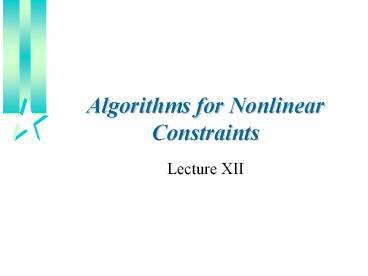Algorithms for Nonlinear Constraints - PowerPoint PPT Presentation
1 / 15
Title: Algorithms for Nonlinear Constraints
1
Algorithms for Nonlinear Constraints
- Lecture XII
2
Algorithms for Nonlinear Constraints (I)
- General Objective
- The general objective is to maximize or minimize
a nonlinear objective function subject to
nonlinear constraints. Gill, Murray, and Wright
lay out the basic problems
3
Algorithms for Nonlinear Constraints (II)
- These optimization problems are much more
difficult than the equality or inequality
constraints posed in the preceding sections due
to the difficulties involved in maintaining
feasibility. - By the formulation of the null-space in the
linear equality scenario, it was always possible
to guarantee that xk1 was feasible given that xk
was feasible.
4
Algorithms for Nonlinear Constraints (III)
- Similarly, expansion to linear inequality
constraints only added caveats to the step length
algorithm and checks on whether a constraint
could be deleted. - However, the solution of nonlinear constraints
may be difficult, if not impossible, without the
incorporation of a nonlinear objective function. - I want to discuss three different methodologies.
- penalty function method.
- barrier functions method.
- projected augmented Lagrangian method.
5
Algorithms for Nonlinear Constraints (IV)
- Penalty Functions
- The penalty and barrier function procedures are
very similar. The primary concept of both
procedures is to append an additional term onto
the objective function which imposes a cost for
violating the constraint. - Taking the Penalty function first, assume that we
want to optimize
6
Algorithms for Nonlinear Constraints (V)
- A quadratic penalty function for this problem
could be specified as
7
Algorithms for Nonlinear Constraints (VI)
- Algorithm DP (Model algorithm with a
differentiable penalty function) - DP1. Check termination conditions. If xk
satisfies the optimality conditions, terminate
with the current solution. - DP2. Minimize the penalty function. Using xk as
the starting point, execute an algorithm to solve
the unconstrained subproblem
8
Algorithms for Nonlinear Constraints (VII)
- DP3. Increase the penalty parameter. Set rk1
to a larger value than rk. and go back to step
DP1.
9
Algorithms for Nonlinear Constraints (VIII)
- Barrier Function
- The barrier function works well when the
constraint can be evaluated either above or below
its constrained value. However, in certain cases,
you may want to guarantee feasibility as a
minimum condition. For this type of problem the
barrier method may be preferred.
10
Algorithms for Nonlinear Constraints (IX)
- Focusing on the logarithmic barrier function, we
create a subproblem similar to that generated in
the penalty parameter framework.
11
Algorithms for Nonlinear Constraints (X)
- Projected Augmented Lagrangian
- Minos 5.1 uses the projected augmented Lagrangian
algorithm to optimize problems involving
nonlinear constraints. - This algorithm as instituted in Minos solves a
sequence of subproblems. - Each subproblem, or major iteration, solves a
linearly constrained minimization (maximization)
problem.
12
Algorithms for Nonlinear Constraints (XI)
- The constraints for this linear subproblem are
the linear constraints plus the linearlized
nonlinear constraints. - Then like the straightforward penalty parameter
method, the penalty can be increased to approach
the nonlinear constraints with an arbitrary level
of precision.
13
Algorithms for Nonlinear Constraints (XII)
- Mathematically, the general problem can be written
14
Algorithms for Nonlinear Constraints (XIII)
- In this problem, the major iteration involves the
linearlization of the constraints around the
point xk. - The first step is to linearlize the nonlinear
constraints around the starting point of the
major iteration
15
Algorithms for Nonlinear Constraints (XIV)
- Given this relationship, the linear constraints
can then be written as































